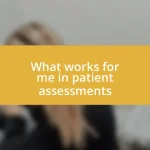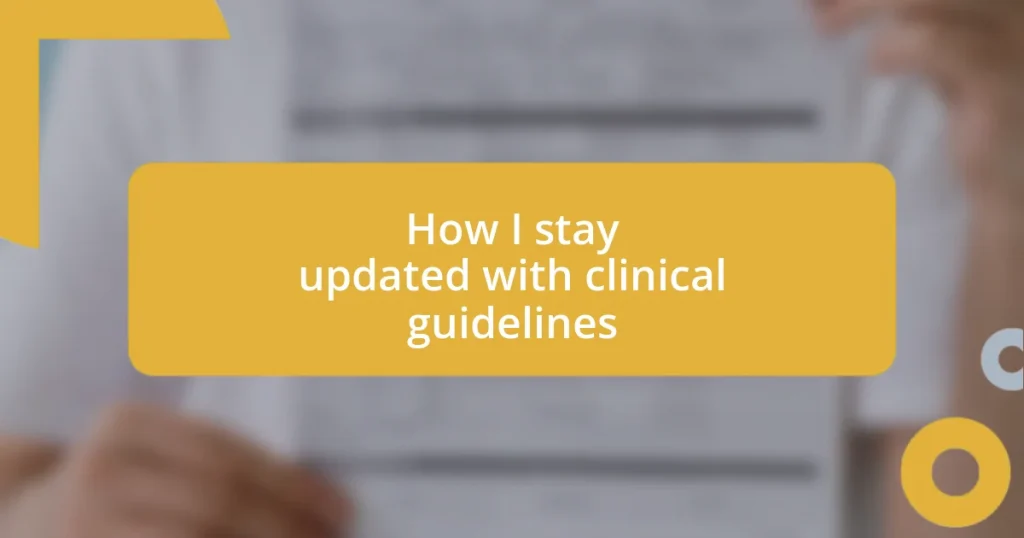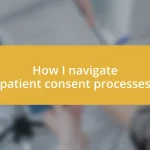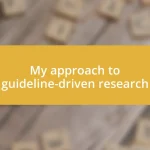Key takeaways:
- Staying updated with clinical guidelines enhances patient outcomes, decision-making, and confidence, while ignoring updates can lead to unsafe practices.
- Key sources for clinical guidelines include professional organizations, government agencies, peer-reviewed journals, online databases, and continuing medical education resources.
- Engaging with professional communities and leveraging technology such as mobile apps and social media fosters continuous learning and enriches clinical practice.
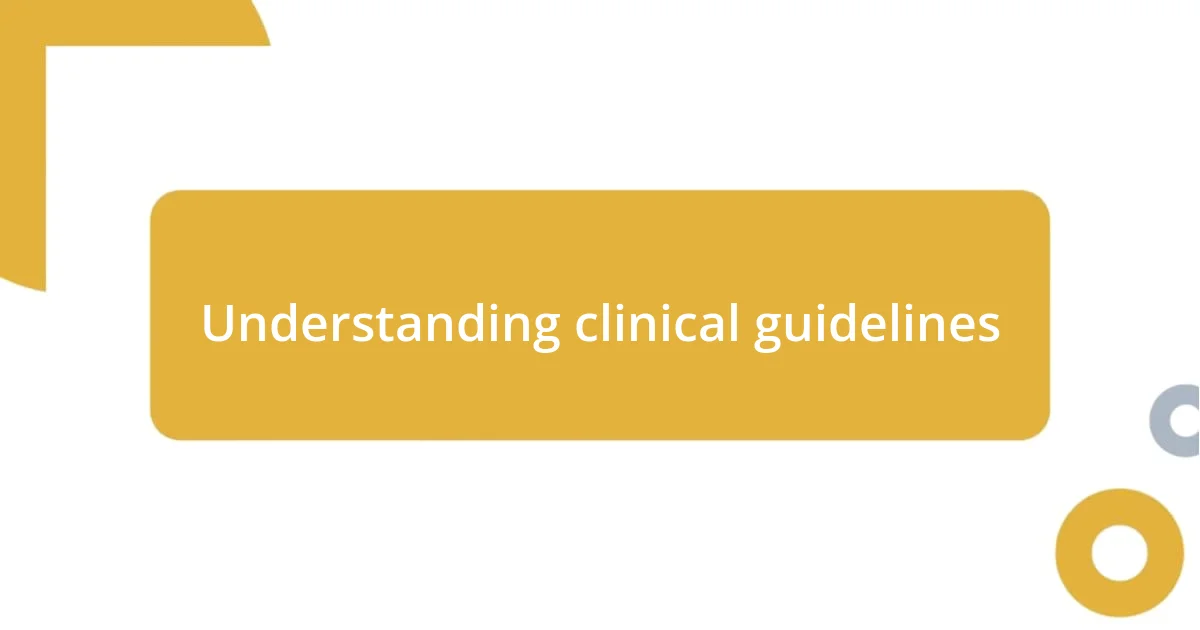
Understanding clinical guidelines
Clinical guidelines are systematically developed statements that assist healthcare providers in making informed decisions about the care of patients. I remember when I first encountered these guidelines during my training; they felt like a treasure map, guiding us towards the best practices tailored for specific conditions. It struck me how crucial they are—not just for keeping our knowledge current, but for ensuring we deliver the safest, most effective care.
As I navigated through various patient scenarios, I often found myself asking, “What does the latest research say about this treatment?” That inquiry underscored the importance of staying up-to-date on clinical guidelines. Each guideline serves as a bridge between evidence-based research and real-world application; they transform complex data into actionable insights that can significantly enhance patient outcomes.
Understanding these guidelines isn’t just about rote memorization; it’s about embracing a mindset of continuous learning. I often reflect on how these documents reflect the evolving nature of medicine. They remind us that health care is not static; each update is an opportunity to reassess our practices. How often do we stop to think about the reasoning behind each guideline? For me, diving deep into these updates sparks curiosity and fuels a passion for providing the best care possible.
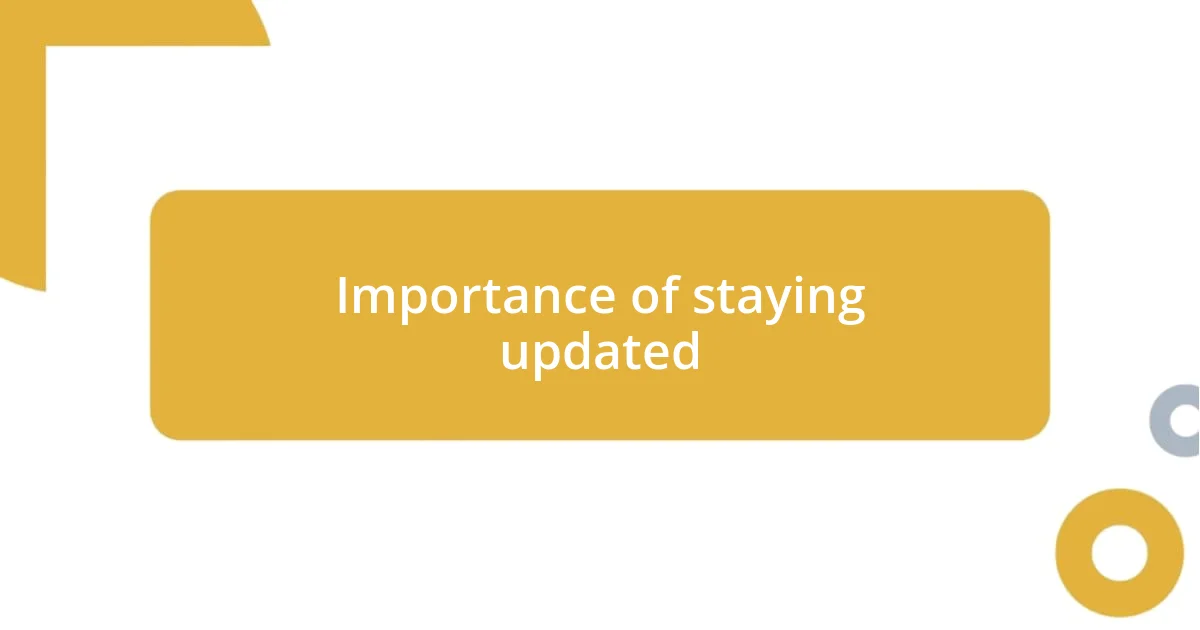
Importance of staying updated
Staying updated with clinical guidelines is essential for providing optimal patient care. Each time new guidelines are released, I feel a sense of urgency to familiarize myself with the changes. It’s like being given a new tool that can better equip me to tackle health challenges. When I see how a guideline has been updated based on recent research, I often reflect on past patient cases where that new insight could have made a significant difference.
I remember years ago when a sudden update in diabetes management affirmed the need to treat patients more holistically. This wasn’t just about lowering blood sugar levels; it emphasized lifestyle factors and mental health. The moment I integrated this understanding into my practice, I saw patients respond in ways I hadn’t expected. They felt empowered, and it made me appreciate even more the profound impact of being informed and adaptable in a constantly changing medical landscape.
Moreover, ignoring these updates can lead to outdated practices that may jeopardize patient safety. I once attended a seminar where a physician candidly shared how overlooking a guideline update led him to prescribe an ineffective treatment for a common condition. It made me realize that the implications of being uninformed extend far beyond my own practice; it affects the very core of patient care and outcomes. Staying current not only enhances my confidence in decision-making but also fosters a culture of accountability and excellence in the healthcare community.
| Benefits of Staying Updated | Consequences of Not Staying Updated |
|---|---|
| Enhanced patient outcomes | Potential for obsolete practices |
| Improved decision-making | Increased risk of patient harm |
| Confidence in clinical practice | Loss of credibility |
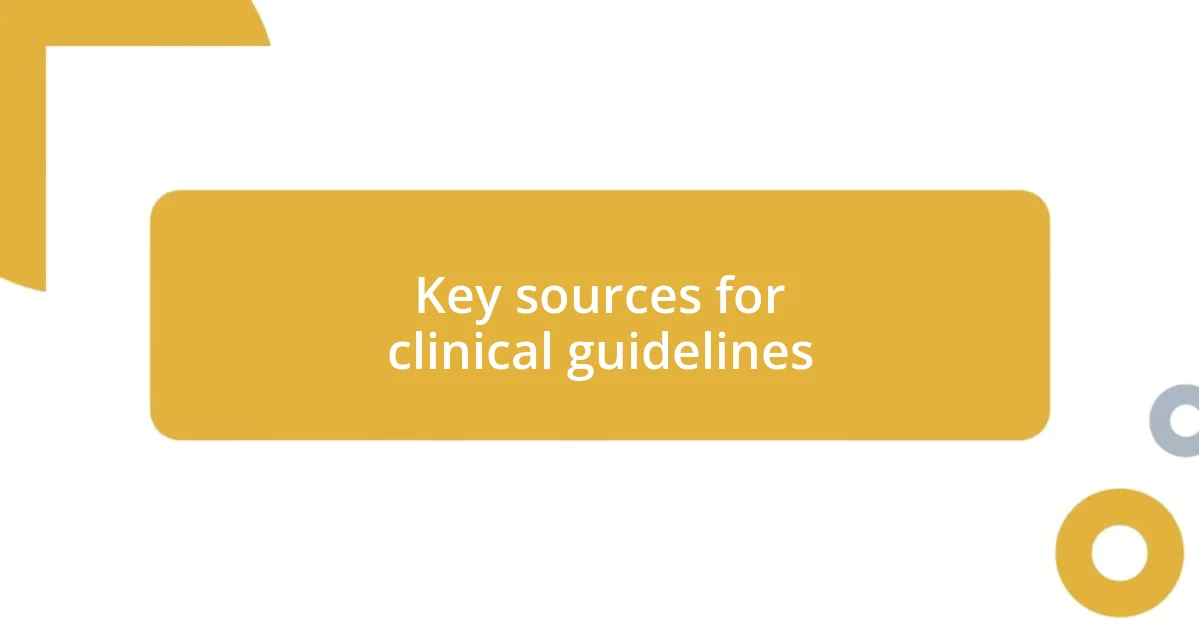
Key sources for clinical guidelines
When it comes to sourcing clinical guidelines, I’ve come to appreciate a handful of key resources that consistently deliver reliable information. I often turn to professional organizations like the American College of Physicians or the World Health Organization, as their publications are not only comprehensive but also continuously updated. Reflecting on my journey, these organizations have been invaluable in shaping my understanding and application of new practices.
Here are some of my go-to sources for clinical guidelines:
- Professional Organizations: Websites from groups like the American Heart Association or the American Diabetes Association often publish the latest guidelines and recommendations.
- Government Agencies: Resources like the Centers for Disease Control and Prevention (CDC) and the National Institutes of Health (NIH) provide evidence-based guidelines tailored for diverse health conditions.
- Peer-Reviewed Journals: Journals such as JAMA or The New England Journal of Medicine frequently feature breakthrough studies that may lead to shifts in clinical guidelines.
- Online Databases: Platforms like UpToDate offer quick access to guidelines along with clinical management tools, which I find incredibly handy in my daily practice.
- Continuing Medical Education (CME) Resources: Many CME courses integrate recent guideline changes, enriching learning while ensuring that I remain aligned with best practices.
Engaging with these resources feels like being part of a larger community of healthcare professionals striving for excellence. I remember the excitement I felt last year when I attended a conference where recent clinical guidelines were dissected by experts in the field. It was inspiring to see how passionately they discussed the potential impacts of these updates on patient care. This sense of shared purpose and commitment to knowledge keeps me motivated to seek out the latest information continuously.
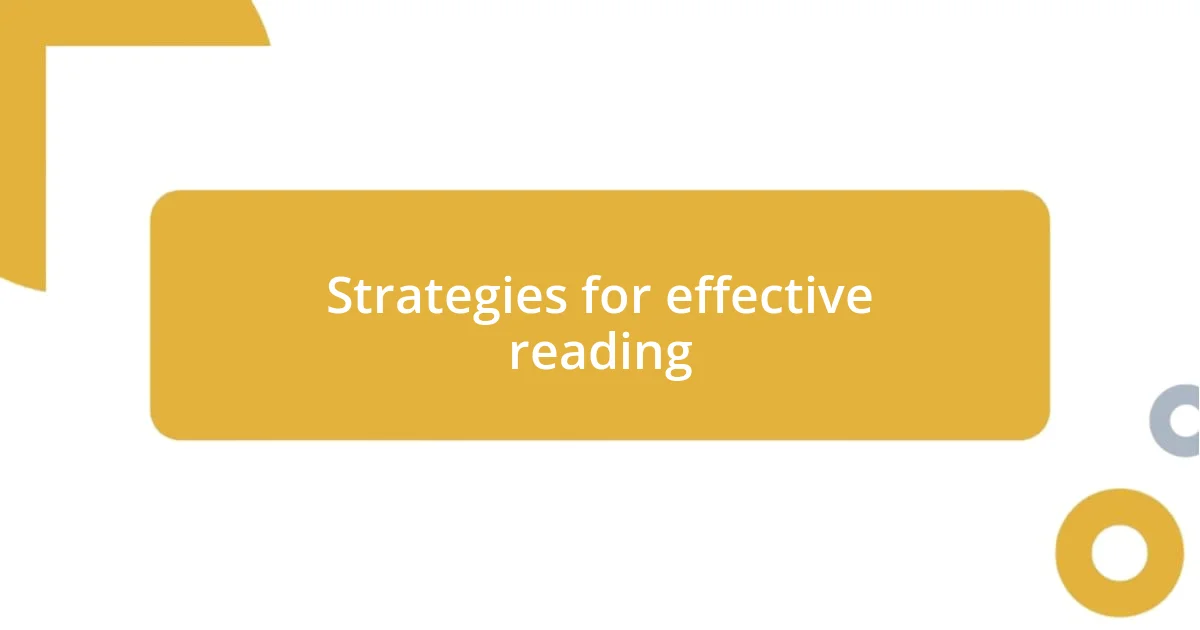
Strategies for effective reading
When I settle down to read clinical guidelines, I find that setting a specific environment is crucial. I prefer a quiet, comfortable space where I can focus without distractions. To further enhance retention, I sometimes jot down key points and my initial reactions in the margins. This active engagement not only keeps me attentive but allows me to process the information more deeply. Have you ever noticed how writing something down aids your memory? For me, it transforms abstract concepts into personal insights.
Another strategy I use is breaking down the reading into manageable sections. I’ve learned that trying to tackle a long guideline all at once can feel overwhelming, often leading to information overload. Instead, I’ll dissect it into smaller parts, savoring each section and reflecting on how those insights apply to my practice. For instance, when I recently read a guideline on hypertension management, I focused on one section per day. Doing this not only made the content digestible but also gave me time to ponder the nuances, such as how cultural factors might influence my approach with diverse patients.
Finally, I often discuss the guidelines with colleagues after my readings. This camaraderie really brings the material to life—it’s fascinating to uncover different interpretations and applications based on our various experiences. I recall a compelling conversation with a fellow clinician who had a unique perspective on implementing new addiction treatment guidelines in our community. It sparked a lively discussion that clarified my understanding and highlighted practical applications I hadn’t considered before. Isn’t it amazing how collaboration can amplify our learning?
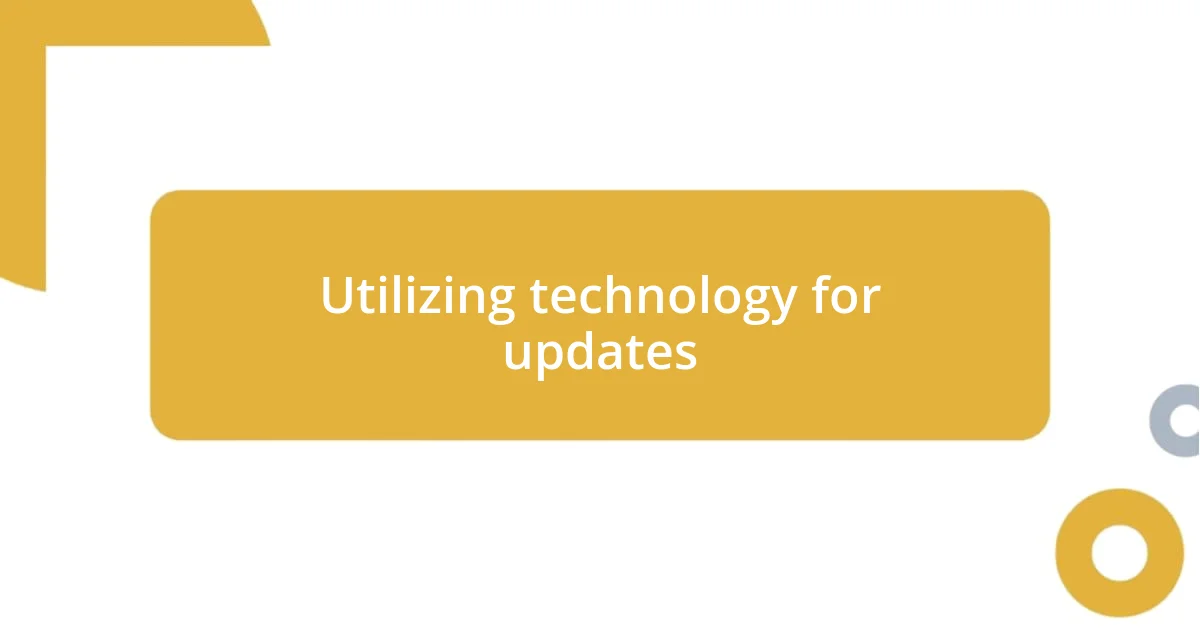
Utilizing technology for updates
I frequently rely on technology to stay current with clinical guidelines. One of my favorite tools is mobile apps that provide instant access to the latest research and updates. Just last month, I downloaded a new app that alerts me whenever a relevant guideline is published. It’s like having a personal assistant for my clinical practice right in my pocket! Isn’t it satisfying to receive timely updates without the hassle of searching through multiple websites?
Moreover, the potential of webinars and online courses cannot be overstated. I remember attending a live-streamed symposium focusing on diabetes management updates while sitting in my living room. The convenience of engaging with experts in real time, while asking questions, felt like a significant opportunity to deepen my understanding. Technology makes these crucial discussions accessible, bridging the gap between leading-edge research and everyday clinical practice. How often do you take advantage of these online opportunities for learning?
Lastly, I appreciate the power of social media in this journey. Following thought leaders in my field on platforms like Twitter has become a daily ritual for me. The discussions that arise in real time often provide new perspectives, and I find myself excitedly reading threads about recent guideline changes while enjoying my morning coffee. There’s something energizing about being part of a global conversation—don’t you feel it when you engage with a community that shares your passion for advancing healthcare?
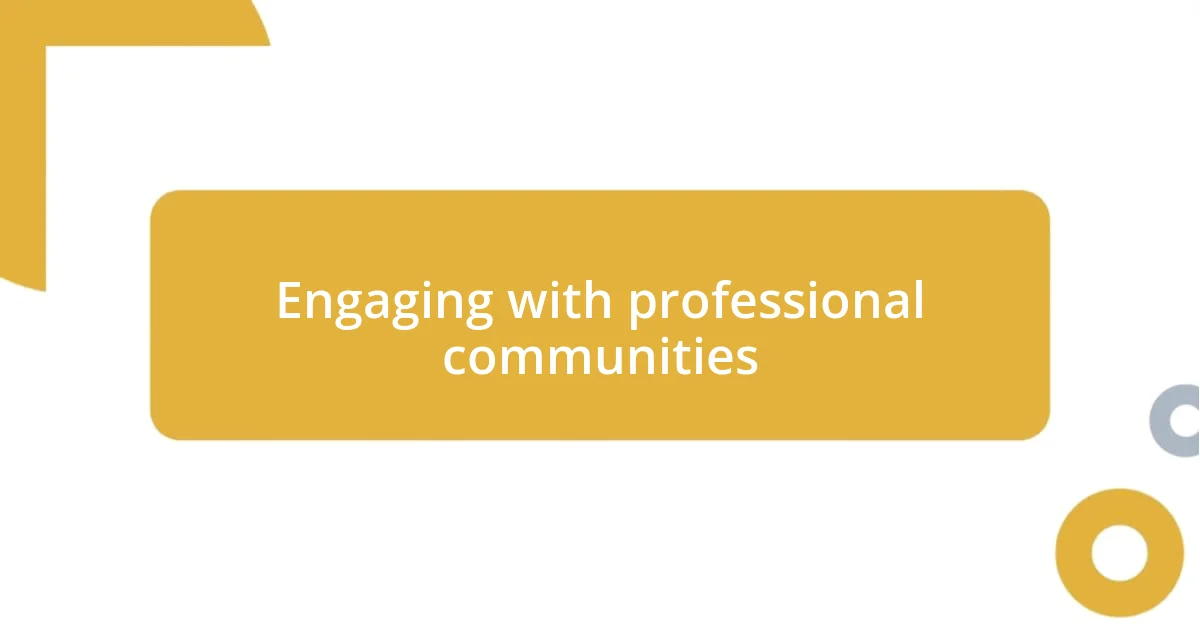
Engaging with professional communities
Engaging with professional communities has been a game-changer for me. I remember attending a local conference where I met a mentor who was passionate about evidence-based medicine. Our conversation opened my eyes to how much I could learn from sharing experiences and challenges. Have you ever found that a single discussion can reshape your approach to practice? It certainly did for me.
Another enriching experience came when I joined an online forum dedicated to clinical guideline updates. I was initially hesitant, thinking I wouldn’t have much to contribute. However, as I started sharing my thoughts, I realized how valuable my perspectives were. Each comment thread became an opportunity for collective learning, where my questions led to conversations that influenced my practice. Doesn’t it feel rewarding to be part of a supportive environment that encourages knowledge exchange?
Furthermore, my involvement in a professional network has significantly broadened my understanding of various clinical perspectives. During a recent virtual meeting, a colleague presented a case study that showcased innovative applications of new guidelines. I found it inspiring—and thought-provoking—how different settings can lead to unique interpretations of the same material. Have you ever been in a situation where you’ve gained insights that transformed your clinical approach? For me, these interactions continually energize my commitment to staying updated.

Evaluating guideline credibility
Evaluating the credibility of clinical guidelines is crucial in ensuring that the information I rely on is trustworthy and applicable to my practice. When I come across new guidelines, my first step is to scrutinize the sources. I often ask myself, “Who developed these guidelines, and what evidence supports them?” For instance, if the guideline originates from a reputable organization with a significant history of sound research, I give it more weight.
Additionally, I look for indications of a rigorous development process. I remember reviewing a guideline that included systematic reviews and meta-analyses as part of its foundational research. This transparency reassured me about its credibility. It’s essential to consider whether the guideline has undergone a peer-review process and if stakeholders were involved in its creation. How often do we overlook these aspects in our rush to find answers?
Lastly, I find it helpful to consider the date of publication, as up-to-date guidelines reflect the latest evidence. I recently encountered a guideline on hypertension management that had been revised within the past year, and it provided fresh insights that prompted me to adjust my approach. So, ensuring that the guidelines I follow are current not only enhances my practice but also empowers me to provide better care for my patients. Have you ever adjusted your practices based on new evidence? It’s a rewarding feeling to know we’re always striving for improvement.

